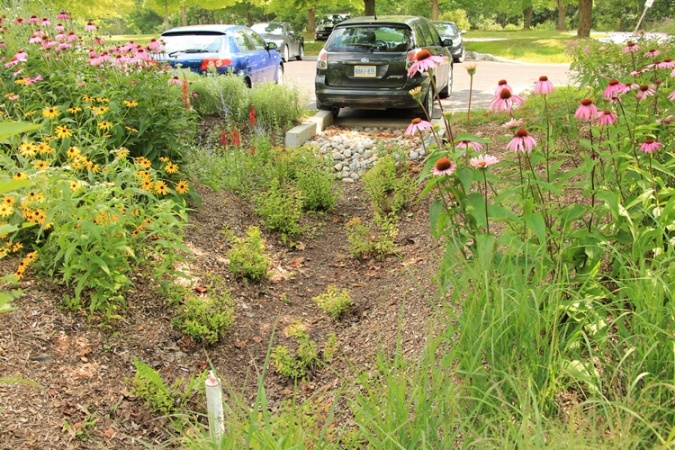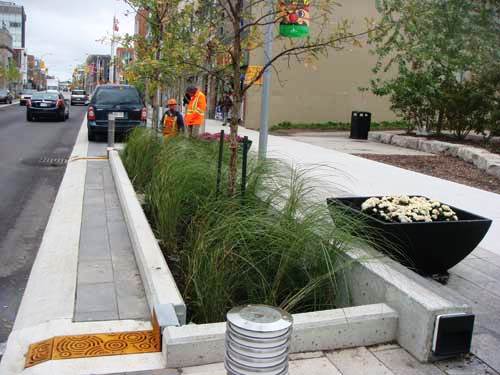Difference between revisions of "Bioretention: Variations"
Jenny Hill (talk | contribs) |
Jenny Hill (talk | contribs) m (Jenny Hill moved page Bioretention cells Variations to Bioretention: Variations: Consistency) |
(No difference)
| |
Revision as of 19:33, 6 July 2017
Types of bioretention by underground design[edit]
Rain gardens
These are the simplest construction, often used by residents or community groups. Volume reduction is through infiltration and evapotranspiration.
Infiltrating bioretention
This is the most highly desirable type of bioretention where the soils permit infiltration at a great enough rate to empty the facility between storm events. Volume reduction is primarily through infiltration to the underlying soils, with some evapotranspiration. As there is no outflow from this BMP, it is particularly desirable in areas where nutrient management is a concern to the watershed.
Partially infiltrating bioretention
Including an underdrain in the gravel storage layer ensures that the facility will empty between storm events even over ‘tight soils’. The drain discharges to a downstream point, which may require a Limited volume reduction is gained through infiltration and evapotranspiration.
Bioretention with storage
By raising the outlet of the discharge pipe the bottom portion of the BMP can only drain through infiltration. This creates a fluctuating anaerobic/aerobic environment which promotes denitrification. Increasing the period of storage has benefits for promoting infiltration, but also improves water quality for catchments impacted with nitrates. A complimentary technique is to use fresh wood mulch, which also fosters denitrifying biological processes.
Bioretention planters (non-infiltrating)
This type may be required over contamination hot-spots or in very dense urban areas with a lot of other underground infrastructure. The design includes an impermeable base and sides, so that volume reduction is made only through evapotranspiration.
| Type | Gravel layer | Underdrain | Liner | Mechanisms | Examples |
|---|---|---|---|---|---|
| Rain gardens | - | - | - | These are the simplest construction, often used by residents or community groups. Volume reduction is through infiltration and evapotranspiration. | Image of Raingarden |
| Infiltrating bioretention | yes | - | - | This is the most highly desirable type of bioretention where the soils permit infiltration at a great enough rate to empty the facility between storm events. Volume reduction is primarily through infiltration to the underlying soils, with some evapotranspiration. As there is no outflow from this BMP, it is particularly desirable in areas where nutrient management is a concern to the watershed. | Diagram of bioretention without underdrain. |
| Partially infiltrating bioretention | yes | yes | - | Including an underdrain in the gravel storage layer ensures that the facility will empty between storm events even over ‘tight soils’. The drain discharges to a downstream point, which may require a Limited volume reduction is gained through infiltration and evapotranspiration. | Image here |
| Bioretention with storage | yes | yes | - | By raising the outlet of the discharge pipe the bottom portion of the BMP can only drain through infiltration. This creates a fluctuating anaerobic/aerobic environment which promotes denitrification. Increasing the period of storage has benefits for promoting infiltration, but also improves water quality for catchments impacted with nitrates. A complimentary technique is to use fresh wood mulch, which also fosters denitrifying biological processes. | Image |
| Bioretention planters (non-infiltrating) | yes | yes | yes | This type may be required over contamination hot-spots or in very dense urban areas with a lot of other underground infrastructure. The design includes an impermeable base and sides, so that volume reduction is made only through evapotranspiration. | Image here |
| Form | Characteristics | Examples |
|---|---|---|
| Infiltrating cells | Used in developments with large landscaping areas, parks, parking lot islands, or any areas without tight space constraints. They have side slopes ≥2:1. Often, they receive sheet flow, but in some cases they are surrounded by curbs and will have inlets. The distinction between these options will determine the recommended types of pre-treatment. |
|
| Rain gardens | Often found on residential sites or on land managed by community organisations . This simple variation may be constructed by the property owner and usually excludes the storage layer. | See main article on rain gardens |
| Bioretention planters (stormwater planters) | Typically used in ultra-urban areas adjacent to buildings and in plazas. They appear similar to traditional landscaped beds, but differ by receiving runoff from nearby surfaces. | Image here |
| Extended tree pits (parallel bioretention) | Located within the right-of-way, occupying the space between sidewalk and street. The inlets can be positioned on either or both sides, and are designed to prevent the system from filling beyond a fixed capacity. When ponding occurs, stormwater bypasses the inlets, making this a 'parallel' system rather than a flow-though or online design. | |
| Curb extensions (bump outs) | Installed in road-right-of-way, these function as a stormwater facility and a traffic calming measure. Inlets are integrated into the raised concrete curb and receive flow from the street side. | Image here |

